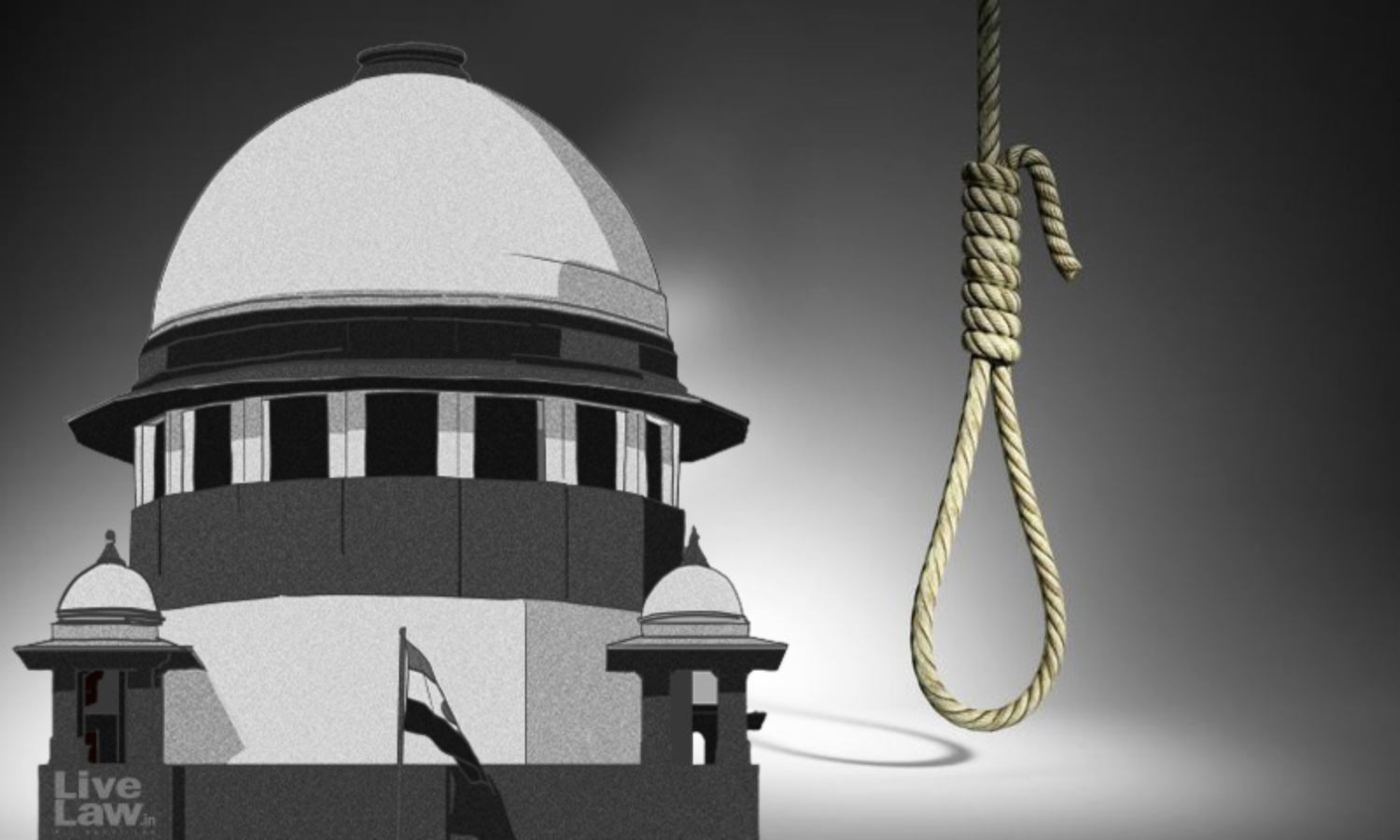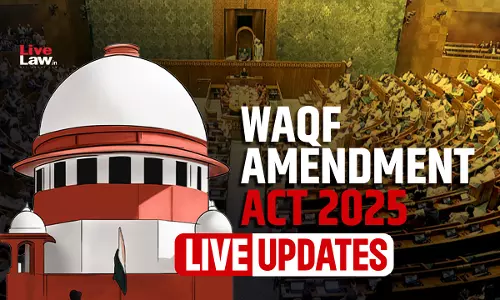'Gaping Holes In Prosecution' : Supreme Court Acquits Man Who Was Sentenced To Death For Rape & Murder

The Supreme Court today(January 28) set aside the judgment of the Bombay High Court which upheld the conviction and the death sentence awarded to the Appellant by the Trial Court for the rape and murder of a 23 years old woman which took place in 2014. The Court acquitted the Appellant of all charges on the ground that when the prosecution is relying on circumstantial evidence to draw home...
The Supreme Court today(January 28) set aside the judgment of the Bombay High Court which upheld the conviction and the death sentence awarded to the Appellant by the Trial Court for the rape and murder of a 23 years old woman which took place in 2014.
The Court acquitted the Appellant of all charges on the ground that when the prosecution is relying on circumstantial evidence to draw home the guilty, it must be proved beyond a reasonable doubt; which is a cardinal principle of criminal law as held in Sharad Birdhichand Sarda vs State of Maharashtra (1984). In this case, the prosecution failed to do so.
A bench of Justices B.R. Gavai, Prashant Kumar Mishra and K.V. Viswanathan held that the facts cumulatively lead to the conclusion that there are "gaping holes" in the prosecution's story.
It held:
"All these facts cumulatively constrain us to conclude that there are gaping holes in the prosecution story leading to the irresistible conclusion that there is something more than what meets the eye in this case. While the old adage, witness may lie but not the circumstances, may be correct, however, the circumstances adduced, as held by this Court, should be fully established."
There is a legal distinction between 'may be proved' and 'must be or should be proved' as held by this Court. The circumstances relied upon when stitched together do not lead to the sole hypothesis of the guilt of the accused and we do not find that the chain is so complete as not to leave any reasonable ground for the conclusion consistent with the innocence of the accused... On the available evidence, we are of the opinion that it will be extremely unsafe to sustain a conviction against the appellant."
By an order dated December 20, 2018, the High Court upheld the death sentence award for the offence of murder and the respective sentences awarded for various offences including kidnapping or abducting to murder. The Appellant was directed to pay a compensation of Rs.50,000 to the deceased's parents.
As per brief facts, the dead body of the young woman, who was travelling to Mumbai where she was working, was found burnt and decomposed.
After registration of the First Information Report, the chemical analysis report stated death due to head injury with smothering associated with genital injuries as the final cause of death. It was further clarified that injuries to the genitals are possible by forcible entry of some article in the vagina (since the defence had raised the issue that no semen was found).
The High Court had stated that post post-mortem report established the body was partly burnt. There was an attempt made to destroy evidence. The High Court also stated that the accused had consumed alcohol and was seen loitering on the railway platform and that the deceased had accompanied the accused while leaving the railway station as per the CCTV footage.
14 circumstantial evidence by the High Court to sustain conviction and sentence
There were in total 14 circumstances drawn by the High Court for sustaining the conviction and sentence of the accused. The Supreme Court addressed circumstances 6 to 13 which concerned the grounds of criminal appeal.
These were: 6. The accused consumed liquor at prosecution witness 12's residence and in company of prosecution witness 9 and was seen leaving on a motorcycle belonging to PW 9.
7. CCTV at the Lokmanya Tilak Terminus disclosed that accused was loitering on the platform at 4:50 am.
8. Deceased last seen in the company of the accused in the CCTV.
9. Accused was seen near the Eastern Express Highway with the trolley bag and a bag pack belonging to the deceased.
10. Accused seen with trolley bad in morning on the date of incident by prosecution witness 13 leaving the building.
11. Accused going to astrologer to wash off his sins 12. Some articles belonging to deceased and identify by her father came to be recovered at the instance of accused
13. Accused in extra-judicial confession to PW 9 disclosed he poured petrol on the deceased and set it on fire after raping and killing her.
What did the Supreme Court observe?
Admissibility of CCTV footage
The Court first made observations in regard to the admissibility of the CCTV footage. It found various infirmities in the evidence led by the prosecution. Most importantly, the prosecution did not furnish the Section 65-B(4) certificate under the Indian Evidence Act while collecting the electronic evidence.
In this context, the Court perused various judgments and considered the settled position of law which was Section 65-B(4) certificate as a condition precedent to the admissibility of evidence by way of electronic evidence as held in Anvar P.V. v. P.K. Basheer (2014).
In this regard, the Court said:
"Thus, when the prosecution was aware of the need for the 65-B (4) certificate and they themselves collected it for the CDRs there was no reason as to why they did not collect the same for the CCTV footage...In view of the above, there is no manner of doubt that certificate under Section 65-B(4) is a condition precedent to the admissibility of evidence by way of electronic record and further it is clear that the Court has also held Anvar P.V. (supra) to be the correct position of law."
Further, the Supreme Court stated that when a matter pertains to the death penalty, the case must be considered in light of the Anvar P.V. judgment. In light of this, in Mohd. Arif v. State (NCT) of Delhi , the Court eschewed the electronic evidence for want of a certificate. Relying on this, the Court in this regard held that it cannot rely on CCTV footage:
"In view of the above, we are not able to place any reliance on the CCTV footage, insofar as an attempt is made by the prosecution to attribute that the appellant and the deceased EA were last seen together based on the CCTV footage. We eschew the same from consideration."
Last seen theory
On this, the Court considered the testimonies of the prosecution witnesses that last saw the Appellant and the deceased.
On this, the Court observed that the prosecution failed to establish the circumstances of the last seen. This was because the two witnesses who had last seen both the Appellant and the deceased, their statements were recorded after two and a half months of the incident and no explanation for the delay was given by the police. Neither of them (PW 20 and 21 )disclosed anything about seeing both the Appellant and the deceased together.
"Analysing the evidence, we must record that the witnesses fail to inspire the necessary confidence that a Court of Law looks for, to clinchingly establish the circumstances of last seen...However, evidence of PW-20 and PW-21 does not point towards the guilt of accused even if we discount all these infirmities. The law on circumstantial evidence mandates that any other hypothesis must be ruled out. This is not a case where any conviction could be sustained even if we believe PW-20 and PW 21 on the basis of their evidence, in view of our holding with regard to the other circumstances, some of which have been recorded hereinabove and some of which are to follow hereinbelow. In view of the same, even we have to assume that the evidence of PW-20 and 21 are to be taken at their face value (which is difficult) we still do not find the evidence clinching to record the conviction."
Apart from the last-seen witnesses, the Court also rejected the testimonies of other witnesses as either not reliable or linked to the Appellant including the astrologer to whom the Appellant had gone.
Considering all this, the Court stated:
"We are really at a loss to understand as to what the prosecution seeks to establish. The priest has no systematic account of maintaining registers and on summoning of the Police, he seems to appear before the Police and produced the register out of the bag. It is also intriguing why the appellant would carry the horoscope as late as on 02.03.2014. In any case, the evidence given by PWs -15 16 and 17 do not constitute circumstantial evidence having any nexus with the commission of the crime in question. We totally discard this from the chain of circumstances."
Extrajudicial confession to PW9
It was the case the PW9 had deposed that the Appellant has confessed to him about the murder and rape of the deceased. However, the Court found that may not have been the case:
"We have carefully considered the efficacy of the extra judicial confession of PW-9. Extra judicial confession, by its very nature, has been held to be a weak piece of evidence. Normally it is given to persons who enjoyed the confidence and trust of the accused. From the evidence mentioned above, we are not able to find that PW-9 enjoyed the confidence of the accused so as to safely infer that the accused would have made a clean breast of things to PW9...Further, from DW-2 read with Article 41, it is clear there are reasonable grounds to believe that PW-9 was in interaction with Police in some capacity. In any event, discounting all that, from the cross-examination portion extracted above of PW-38 with so many omissions in the statement of PW-9, we do not feel it prudent to sustain the conviction based on the purported extra judicial confession given to PW-9. Moreover, there is no corroboration in material particulars and hence we are inclined to reject the extra-judicial confession purportedly given to PW-9."
Lastly, the Court rejected the trolley recovered because the witness from which it was recovered could not even remember who gave her the trolley.
Relying on Sharad Birdhichand Sarda, which lays down the test of circumstantial evidence, the Court concluded: "The prosecution has not established its case beyond reasonable doubt. Hence, we are constrained to come to the sole irresistible conclusion that the appellant is not guilty of the offences for which he has been charged."
Case Details: CHANDRABHAN SUDAM SANAP v. THE STATE OF MAHARASHTRA| CRIMINAL APPEAL NO. 879 OF 2019
Appearances: Advocate Shri Singh appeared for NLUD's Project 39A which provided legal aid to the Appellant
Citation: 2025 LiveLaw (SC) 119




